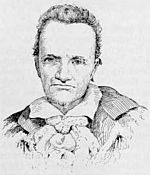Appletons' Cyclopædia of American Biography/Red-Jacket

|
RED-JACKET, or SAGOYEWATHA (“He keeps them awake”), chief of the Wolf tribe of the Senecas, b. at Old-Castle, near Geneva, N. Y., 1751; d. in Seneca Village, N. Y., 30 Jan., 1830. The name of Red-Jacket, by which he was familiarly known, was given him because he had been presented by an English officer, shortly after the Revolution, as a reward for his fleetness of foot, with a richly embroidered scarlet jacket, which he took great pride in wearing. After the death of Brant, Red-Jacket became the man of greatest importance among the Six Nations. He was upon the war-path during both the conflicts between the United States and Great Britain. In the Revolution he served with his nation the cause of the crown. In 1812-'13 — the Senecas having changed their allegiance — he fought under the colors of the United States. He was deficient in physical courage; so much so, as to receive from Brant the nickname of the “Cow-Killer” though it is said that in the action in 1813 near Fort George, on the Niagara frontier, he behaved with great bravery. At a council at Fort Stanwix in 1784, to negotiate a treaty between the United States and some of the Six Nations, he delivered an eloquent and scathing philippic against the treaty, which was nevertheless ratified. At this council he resumed his Revolutionary acquaintance with Lafayette, who chanced to be present. In 1792 Washington, on the conclusion of a treaty of peace between the United States and the Six Nations, gave him a medal of solid silver, which he prized highly and wore until his death. It is now (1888) in possession of Gen. Ely S. Parker. In 1810 he gave valuable information to the Indian agents of the attempts of Tecumseh and the Prophet to draw the Senecas into the western combination. His hostility to Christianity was implacable, and he was the most inveterate enemy of the missionaries that were sent to his nation. He was a thorough Indian in his costume, as well as in his undisguised contempt for the dress and language of the whites and anything else that belonged to them. He was of a tall and erect form, and walked with dignity. His eyes were fine, and his address, particularly when he spoke in council, was almost majestic. In his later years he became a confirmed drunkard and sank into mental imbecility. Red-Jacket's character was singularly contradictory. Lacking firmness of nerve, he nevertheless possessed remarkable tenacity of purpose and great moral courage, and his intellectual powers were of a very high order. He was a statesman of sagacity and an orator of surpassing eloquence, yet he was capable of descending to the lowest cunning of the demagogue. But he was still a patriot, and loved his nation and his race, whose extinction he clearly foresaw, and continued to labor with all his energies to put off the evil day. For many years after his death no memorial marked his grave, but on 9 Oct., 1884, his remains were removed and buried, under the auspices of the Buffalo historical society, in Forest Lawn cemetery near that city, Hon. William C. Bryant, of Buffalo, delivering an oration. The proceedings, with additional papers by Horatio Hale, Gen. Ely S. Parker, and others, were published (Buffalo, 1884). Several portraits were taken of the great Seneca. George Catlin painted him twice, Henry Inman once, and Robert W. Wier in 1828, when he was on a visit to New York city; Fitz-Greene Halleck has celebrated him in song. With as much justice as Rienzi has been styled the last of the Romans, may Red-Jacket be called the last of the Senecas. Like Rienzi, he was more energetic in speech and council than in action, and failed in courage and presence of mind in great emergencies. The vignette is from Wier's portrait. See his life by William L. Stone (New York, 1841).